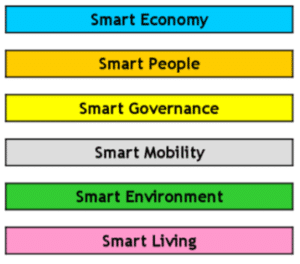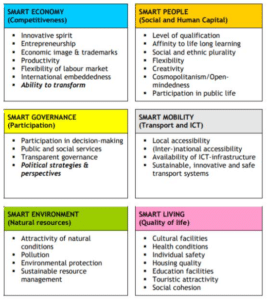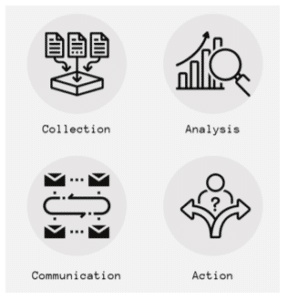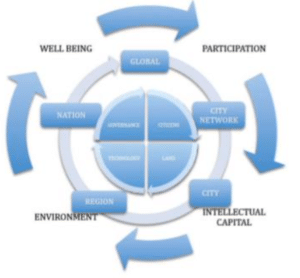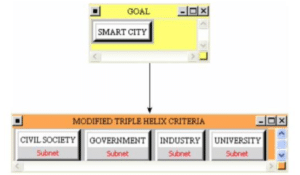Report: Impact of Smart Cities, Startups, and Co-Working on Gender Equality 1/4
Antonia Terriuolo, with Margherita Girotto, Anastasiia Chaikovska wrote an excellent report on how smart cities, startups and co-working contribute to gender equality at Ca’Foscari University of Venice. The first important findings of the report are presented below.
1. Introduction
Living in a globalized world has given rise to many opportunities, but also challenges. In a world more connected than ever before, we try to remain who we are as individuals, whilst forming important networks around the world so as to not fall behind in the whirlwind that is our economic landscape today. Increasing innovations, and constantly changing technology, force individuals, companies, and governments, to adapt and implement the changing nature of everyday life into policy, private, and working landscapes, respectively. In this respect, Smart Cities have attracted substantial attention and funding over the last few years. Given the literary body of work, it may be concluded that such innovations have a positive impact on the urban economic process. Since the unique context of each city shapes the technological, organizational, and policy aspects of a city, the concept can be considered an innovation in the technological, managerial, as well as organizational field. The report focuses on this innovation contributing to the development of Sustainable Development Goal (SDG) number 5, which addresses Gender Equality. The Smart City concept has been chosen as the main innovation of the research. The paper examines the implications of the different understandings of the Smart City concept; for cities’ abilities to be innovative, safe, and secure to promote gender equality. The report covers the following main topics: a description of the chosen innovation, its concept, and origin; the relevant literature review follows, as well as a description of the theoretical model of Smart Cities, and its implication for gender equality. Thirdly, it covers the economics of innovation, the relevance of industry 4.0, the market structure of the chosen innovation, and its innovation type. Lastly, a case study of Safe & The City startup follows to put the theoretical research into a real-life perspective. The research also includes opinions and suggestions based on two interviews conducted with different companies aiming to promote SDG number 5. As one interviewer has not indicated their agreement with the publication of this report, the authors of this report aim to address the Smart City concept as an innovation promoting greater inclusion, safety, resilience, and sustainability so that cities may prosper and provide equal opportunities to all their residents, whilst putting it into the context of the need to address gender equality at a national level. An improvement of gender equality, or ideally an elimination of gender inequality, nationally, will have a positive impact on a global scale. Consequently, providing the relevance of the chosen topic given the scope of globalization mentioned before.
2. Smart Cities: An Approach to Better Living
Given the rise of technology and focus on innovation by regional decision-makers, the concept of Smart Cities provides valuable insights into how a regional area can adapt to the demands of the fast-paced world we live in. Therefore, this chapter aims to explain the concept of Smart Cities concerning sustainability, as well as provide a theoretical model for the Smart City application. Lastly, the concept’s functioning in the marketplace is explained to provide a general knowledge base for the report to come.
2.1. Sustainability Challenges and the Role of Smart Cities
Human presence since the Industrial Revolution has had serious impacts on the planet. The population’s growth and active role have led to negative consequences on the Earth system (Steffen, Grinevald, Crutzen & McNeill, 2011). We can use the term Anthropocene to define this era in Earth’s history; focusing on changes humanity is experiencing in the living world, we can help change the way human behavior is negatively affecting the natural climate life cycle, and, in other words, the ability for future generations of living without eco-geological disasters daily (Ny, MacDonald, Broman, Yamamoto & Robert, 2006).In 2018, 55% of the world’s population was living in urban areas, this is expected to rise to 68% in 2050, adding a further 2.5 billion people (United Nations, 2018) to the population over the next three decades. Moreover, the population’s growth and the moving from rural to urban areas have increased the need to manage environmental, social, and economic sustainability of resources (European Commission, nd a) having given rise to the concept of Smart Cities. As an innovation for this report, the authors focused on the previously mentioned concept. Smart Cities may be defined as cities where “investments in human and social capital and traditional (transport) and modern (ICT) communication infrastructure fuel sustainable economic growth and a high quality of life, with a wise management of natural resources, through participatory governance” (Caragliu, Del Bo & Nijkamp, 2011, p. 50), generally, ICT refers to Information and Communications Technology. Additionally, the main goal of a smart city is to optimize city functions and promote economic growth whilst also improving the quality of life for its citizens by using smart technologies and data analysis. Therefore, Smart Cities highlight important aspects of sustainability, such as the need for responsible resource management using digital technologies, energy efficiency, and citizen engagement (European Commission, nd a). The concept behind Smart Cities could help a city reach sustainability only if “it allows it to function within the natural boundaries of the Earth” (Colldahl, Frey & Kelemen, 2013, pv). Consequently, adopting a Smart City strategy would be beneficial for a local urban area, not only from an environmental aspect but also from a social point of view, as it allows the continuation of human life in that area.
2.2. Smart City Model: A Theoretical Approach to Innovation
Even though the definition of Smart Cities is not always precise, sometimes unambiguous, and depends on the context within which it is referred to, the previously mentioned definition by Caragliu, Del Bo, and Nijkamp (2011) provides a good basis for the development of the Smart City Model by Giffinger et al. (2007). This model consists of a classification system where a Smart City is supposed to contain six characteristics (Smart Economy, Smart People, Smart Governance, Smart Mobility, Smart Environment, and Smart Living), as shown below (Fig. 1).
Fig. 1: Characteristics of a Smart City (Giffinger et al. 2007, p. 13).
The model was built as a ranking tool to evaluate mid-sized European Smart Cities in areas of the economy, people, governance, mobility, environment, and living by examining the current growth state of a city and identifying areas requiring further development to reach levels to be considered a Smart City (Giffinger et al., 2007). Given its European framework, this model is of paramount importance to this report, as all companies are considered in Europe. According to the model each characteristic has its respective determinant factors visualized below (Fig. 2). However, the characteristics may be described as follows:
1)Smart Economy: refers to the overall competitiveness of the city based on its innovative approach considering the R&D expenditures invested, productivity, opportunities, and the flexibility of labor markets. and the role played in the national and international market;
2)Smart People: involve ensuring a high level of education, delivering cultural awareness, having high social interactivity, and a good grade of open-mindedness between citizens and their full participation in public life;
3)Smart Governance: this means participation at the municipal level as a result of transparency in the decision-making process. ICT technology helps trace and interpret citizens’ data to increase efficiency towards security issues;
4)Smart Mobility: recommends an efficient transportation system ahead of time (ie, electric mobility) and promotes a new approach towards the usage of private vehicles. Moreover, ICTs are supporting this system to orchestrate greater efficiency in the transportation of people and different types of items;
5)Smart Environment: highlights the importance of Corporate Social Responsibility (CSR) and Resource Management in both private and public fields to manage the use of natural resources;
6)Smart Living: is about enhancing the quality of life related to the cultural, social, housing, tourism, and health spheres. Citizens in smart cities should have easier access to health care services, electronic health management, and other types of social services (Giffinger et al., 2007).
Fig. 2: Six Characteristics and Respective Factors of the Smart City Model (Giffinger et al., 2007, p.12).
These characteristics and factors contribute to forming the framework for Smart Cities’ performance indicators. These indicators describing the factors are collected from databases deriving from freely available public data and concur in the assessment of a city’s performance as a Smart City (Giffinger et al., 2007). Given the theoretical model, implementing a Smart City Strategy does not end with the implementation of government policy decisions. More so, it is an ongoing process that requires constant reviews and revisions on whether the development is still on track or if additional adjustments to the strategy must be made. Therefore, implementing a Smart City strategy today will ultimately influence the way a city/government does things within a local region for a long time to come.
2.3. Smart Cities Marketplace and Functioning
Smart City implementation has been made possible through the creation of the Smart Cities Marketplace, established by merging two former platforms, the Marketplace of the European Innovation Partnership on Smart Cities and Communities (EIP-SCC Marketplace) and the Smart Cities Information System (SCIS) (European Commission, nd a). It’s a major market-changing undertaking that aims to bring cities, industries, Small and Medium-Sized Enterprises (SMEs), investors, banks, researchers, and many other Smart City actors together. Moreover, the Smart Cities Marketplace has many followers from all over Europe and beyond, many of which have signed up as a member. Their common aims are to improve citizens’ quality of life, increase the competitiveness of European cities and industry as well as reach European energy and climate targets. Additionally, it focuses on different areas of cross-cutting operation; including sustainable urban mobility, sustainable districts, and built environment, integrated infrastructures and processes in energy, information, and communication technologies, and transport, but also dwells on citizen care, policy, and regulation, and knowledge sharing. It also assumes the implementation of integrated planning and management, baselines, performance indicators, standards, and metrics, open data governance, business models, procurement, and funding. The Smart Cities Marketplace’s operations are delivered due to its integrated Explore-Shape-Deal Matchmaking process. It strives to get the maximum knowledge exchange on the capacity-building support for, and the development, implementation, replication, and upscaling of Smart City solutions. Furthermore, it is made up of three phases that follow a consecutive nature. In other words, one phase cannot be reached if the previous phase has not been completed:
1)Explore: consisting of the accessing and collecting of information and knowledge regarding Smart Cities. It is a continuous project, helping to maintain the big picture framework to understand which are the more adequate solutions and best practices, considering the ones that have already been implemented.
2)Shape: this is about the shaping of the project and its action plans. In this phase, it will be possible to create a dialogue with and between all stakeholders involved and to shape the initial idea into a solid project, which is fit to attract public and private investors.
3)Deal: the third and last step is about creating relations and opportunities enabling a one-to-one exchange between project creators and members of the financing community to close deals and finance projects (European Commission, nd b). Finally, we are now able to outline steps a Smart City follows, once implemented, on a daily basis. First, smart sensors collect data in real-time, then data is analyzed to gain insights into the functioning of city service and operations. Therefore, data analysis results are communicated to decision-makers who take actions to improve operations, manage assets and improve the quality of life for urban residents (TWI Ltd, nd), these steps are depicted graphically below (Fig. 3).
Fig. 3: Smart Cities Working Process
3. Comprehensive Review of the Smart City Concept
Adding another layer to the discussion of Smart Cities, the following chapter proposes a theoretical definition, the theoretical framework, and real-life application of Smart Cities based on a thorough literature review.
3.1. Defining Smart Cities
As with every theoretical concept within a certain research field, a conclusive and well-formulated definition of the respective concept is needed to ensure the same starting point, in terms of understanding. This chapter aims to do just that by exploring the relevant literature available to reach an all-encompassing definition of Smart Cities.
3.1.1. Theoretical Definition of Smart Cities
Generally, “a city can be defined as ‘smart’ if it adopts an innovative collaborative governance style to design urban policies aimed at improving citizens’ quality of and at promoting environmental, economic, and social sustainability” (Nesti, 2019, p. 289 ). The discourse around Smart Cities incorporates a topic of high relevance when talking about sustainability: the Triple Bottom Line, which integrates said spheres (social, environmental, and economic) (Alhaddi, 2015). Therefore, it provides a new framework for companies to conduct their business and consider more than just their traditional bottom line. Moreover, it highlights the importance of issues like CSR, and the general role businesses play in creating a more sustainable world. This goal is represented by the United Nation’s SDGs, which will be the focus of a later chapter. Talking about Smart Cities, their main components are civic participation and inclusion (Nesti, 2019), stressing the collaborative approach this innovation makes use of. This is furthered by the growing size of the population, as well as the increasing complexity of city management that calls for technological solutions for urban spaces and public services, which is where Smart Cities develop. Therefore, the concept combines technology, with an environmental aspect, and the well-being of its inhabitants. Consequently, its actors are the country/area of the city, citizens, technology, and the government, which should be measured and defined within specific goals for each aspect. Moreover, the concept of Smart Cities starts at the national sub-level of a certain city, but given its technological and innovative aspect, it can be connected through networks of cities, towards a national, or even global dimension (Dameri, 2013). This interconnection of aspects is visualized in the figure below (Fig. 1). From these findings a comprehensive definition can be derived leading to the following: “a Smart City is a well defined geographical area, in which high technologies such as ICT, logistic, energy production, and so on, cooperate to create benefits for citizens in terms of well being, inclusion and participation, environmental quality, intelligent development, it is governed by a well-defined pool of subjects, able to state the rules and policy for the city government and development” (Dameri, 2013, p. 2549).
Fig. 4: Smart City Comprehensive Scheme (Dameri, 2013, p. 2549).
The above-explained theoretical concept of Smart Cities can be used to measure and assess the difference or conformity between the empirical definition and the real-life realization of the concept. Furthermore, it may be used to help cities develop evaluation tools to review the efficacy of public policies, as well as private initiatives to further help with the development of Smart Cities (Dameri, 2013). Additionally, experiences made by one city can help the development of initiatives in other cities further highlighting the collaborative approach and usefulness of Smart Cities across borders, may they be national or international.
3.1.2. Gender Equality in Smart Cities
Given the scope of this report, the innovation of Smart Cities will be reviewed about gender equality within the following.
Given the fact that increasing gender equality, or decreasing discrimination against females, calls for a multi-stakeholder approach, knowledge of the local space, ie, the city, should be used when creating Smart Cities. More specifically, it means to use past experiences within a certain urban environment to improve women’s experiences in those areas today and in the future. In this regard, literature talks about gender-balanced urban technologies ensuring that women play an active role in the establishment of a safe system, rather than being solely at the receiving end of it (Baskaradas & Reilly, 2020), once again, stressing the participatory aspect of smart cities. Given the social nature of the issue of gender inequality, it leads to the conclusion that, besides technology, Smart Cities also incorporate issues of social science. In other words, it deals with an improvement of the quality of life, whilst developing public services that are inclusive in nature, consequently, reducing inequality (Sasanapitak & Amornsiriphong, 2020). In this context, the business case within this report will shed light on how to use past data to improve women’s safety. Additionally, the United Nations have also focused on including gender equality in the development of Smart Cities. Thus, stressing the importance of protecting women from violence and emphasizing their participation to create economic empowerment (Mehta & Yadav, 2016). This is especially relevant in less developed countries where women are not given the same chances as their male counterparts.
3.2. Framework of Smart Cities
Having explained the theoretical framework of Smart Cities, previously, it emphasizes the opportunity it provides policymakers with for the creation of sustainable and completely inclusive cities for future generations. Baskaradas and Reilly call this a “smart revolution” (2020, np). Furthermore, the literature review revealed that the Triple Helix Model has been revised to adequately address the new scheme of Smart Cities. Moreover, the Triple Helix Model is used in the analysis of knowledge-based innovation systems, relating reciprocal, as well as multiple relationships with its three components, which are university, industry, and government. In other words, universities and governments produce knowledge, whereas the industries and universities produce patented innovations. Furthermore, those innovations are then used as an index to assess the intellectual capital within an area. Therefore, the model makes use of the process of knowledge creation and the capitalization of those creations, provided by the three main agents to, in turn, create Smart Cities (Lombardi, Giodano, Farou & Yousef, 2012). This relationship and a depiction of the Triple Helix Model may be found below (see Fig. 2).
Fig. 5: The Main Network (Lombardi, Giodano, Farou & Yousef, 2012, p. 145).
3.3. Real-Life Application of Smart Cities
Previous subchapters have explored the theoretical aspect of Smart Cities within the available literature. However, practical applications of the model can be found in the literature published on the topic as well.
In this context, researchers have compared London and Berlin with each other, since both are ICT-heavy cities with Smart City agendas for the future and a plethora of sharing platforms available. By supporting smart agenda programs, and facilitating urban sharing; the two cities have the aim to further technical innovation and the emergence of startups. However, research also shows that, although these initiatives exist, they are rare. Thus, leaving room for future improvement to increase the number of urban sharing initiatives. Additionally, the research also identifies “four roles cities may undertake in their efforts to govern ICT-enabled urban sharing: the city as a regulator, city as a provider, city as an enabler, and city as consumer” (Zvolska, Lehner, Voytenko Palgan, Mont & Plepys, 2019, p.640). Generally, other researchers looked at the Smart City initiatives of three different cities: Hamburg, Berlin, and Enschede. Specifically, these three cities have introduced participatory strategies to become a Smart City, in the process of improving the workings of the government. Looking at the case of Berlin, the city employs the Smart City Strategy which sets out to fulfill the following aspects:
1) Combining multiple information sources;
2) Using an integrated approach to increase the efficiency and use of resources; and,
3) Berlin uses active citizen and investor involvement to make the city attractive, and feasible in the coming years in the name of the common good with the end goal being an improvement of the quality of life.
One of the main goals of this strategy is to make the city more competitive internationally and market its innovativeness more effectively. Therefore, Berlin’s Smart City Strategy aims to digitalize the government and its public administration, as this is highly bureaucratic in Germany. Within the study, the researchers questioned multiple employees of the city of Berlin, who named the Smart City Berlin Network as the most meaningful aspect of the Smart City Berlin. Moreover, it was found that the participatory nature of the strategy is indispensable for its success, further proving previous claims of the importance of the participatory nature when talking about Smart Cities. Specifically, the research identifies digital strategies and applications to be more successful when citizens have signed off on them previously. to do so marketing strategies are employed to communicate with citizens using social media outlets, leading to e-participation. Moreover, Berlin uses an e-participation strategy by using Open Data, where interested people can find information on different topics, for instance, senate solutions. It is called Mein Berlin, translated to My Berlin, which is the main future participatory instrument in Berlin. Additionally, innovations from industries have been created to offer smart governmental solutions. One of which is called the DIALOG BOX, translated to Dialogue Box, setting out to improve, and thus, effectively facilitate communication between citizens and the government. Furthermore, the software’s main goal is to facilitate citizen participation, once again, highlighting the participatory nature of Smart Cities. However, the main issue in Berlin remains the fact that even though networks are seen as incommensurable, most plans for the Berlin Smart City Strategy remain just that; as the networks and exchange of information and ideas have not yet led to any groundbreaking steps toward making Berlin a truly Smart City (Spil, Effing & Kwast, 2017). It may be assumed that Germany is not the most fertile ground for such innovations to be implemented, as the country is deeply intertwined in a bureaucratic way of doing things, which requires a long time and a lot of willingness to be changed. Moreover, the assumption that Germany in general is more skeptical of such initiatives is supported by the findings of Zvolska, Lehner, Voytenko Palgan, Mont, and Plepys (2019). most plans for the Berlin Smart City Strategy remain just that; as the networks and exchange of information and ideas have not yet led to any groundbreaking steps towards making Berlin a truly Smart City (Spil, Effing & Kwast, 2017). It may be assumed that Germany is not the most fertile ground for such innovations to be implemented, as the country is deeply intertwined in a bureaucratic way of doing things, which requires a long time and a lot of willingness to be changed. Moreover, the assumption that Germany in general is more skeptical of such initiatives is supported by the findings of Zvolska, Lehner, Voytenko Palgan, Mont, and Plepys (2019). Most plans for the Berlin Smart City Strategy remain just that; as the networks and exchange of information and ideas have not yet led to any groundbreaking steps towards making Berlin a truly Smart City (Spil, Effing & Kwast, 2017).
4. Economics of Innovation
Concerning the economics of the Smart City innovation, a selected range of questions is answered in the following to bring more depth to the discussion of Smart Cities in the realm of innovation.
4.1. What is the characteristic of the innovation? Is it a Radical or an Incremental Innovation?
Radical or disruptive innovation is an innovation that has a significant impact on a market and on the economic activity of firms in that market. This concept focuses on the impact of innovations as opposed to their novelty. The innovation could, for example, change the structure of the market, create new markets, or render existing products obsolete. However, it might not be apparent that innovation is disruptive until long after it has been introduced, and the cut-off point between incremental and radical innovation might be set at different levels. This makes it difficult to collect data on disruptive innovations within the period reviewed in an innovation survey, typically two years. In Schumpeter’s view “radical” innovations create major disruptive changes, incremental innovation concerns an existing product, service, process, organization, or method whose performance has been significantly enhanced or upgraded. Thus Safe & The City may be considered an incremental innovation as it doesn’t create new concepts or products, as it focuses on marginal improvements to what already exists.
4.2. Is it an Open Innovation?
Open Innovation is a paradigm that assumes that firms can and should use external ideas as well as internal ideas, and internal and external paths to market, as the firms look to advance their technology. Open Innovation combines internal and external ideas into architectures and systems whose requirements are defined by a business model (Chesbrough, 2003). Considering the definition explained by Prof. Chesbrough, Safe & The City can be recognized as Open Innovation. This innovation doesn’t just rely on their internal knowledge, sources, and resources (such as their staff or R&D for example) for innovation but gathers information from its users, partners, and authorities.
4.3. What is the Market Structure and the Pattern of Diffusion?
Since the late 2000s, the term Smart City has appeared with increasing frequency in both policy and academic debate, to the extent that by now it may even have eclipsed earlier urban sustainability concepts, such as the sustainable city and eco-city (Joss, 2015 ). The concept of a Smart City is not new and has been applied by many startups and large companies. Therefore, the market structure of Smart City innovations is quite saturated. But what differentiates Safe & The City from other market players is that there are a lot of apps bringing you from point A to point B. But none of them care about your safety as Safe & the City does. It is also the only app that is committed to the United Nations Sustainable Development Goals (SDG) and does not represent a market standard.
4.4. Does the Innovation have a Social Impact? Is it a Local Innovation?
Safe & The City is on a mission to become the world’s most responsible data insights provider to enable the design of smarter and safer cities. The app may be worked with to safeguard its users, whether they are on a date, meeting new people, or whilst traveling to and from locations. Additionally, the bigger its platform grows, the greater its impact on society will be. Moreover, the more technology can reflect the spaces we feel safe in, the more time people will want to be there (Kowalchuk, nd). Safe & The City is based in London for now but sees itself as a global data company. With such ambitions, the company may not be considered a local innovation, although it impacts society on a local level.
4.5. Industry 4.0: Is the Innovation Related to I4.0?
Industry 4.0 represents the fourth revolution that has occurred in manufacturing. From the first industrial revolution (mechanization through water and steam power) to the mass production and assembly lines using electricity in the second, the fourth industrial revolution will take what was started in the third with the adoption of computers and automation and enhance it with smart and autonomous systems fueled by data and machine learning (Marr, 2018). Safe & The City is related to I4.0 as its data-driven platform scans millions of data sources to inform you whether you’re heading into a dangerous situation or a crime hotspot. It draws on data from partner organizations to provide users with safe routes around the city, raising awareness of risk and enabling easier reporting of harassment.
Part 1 of 4. We hope you liked the report, and look forward to the next part.

